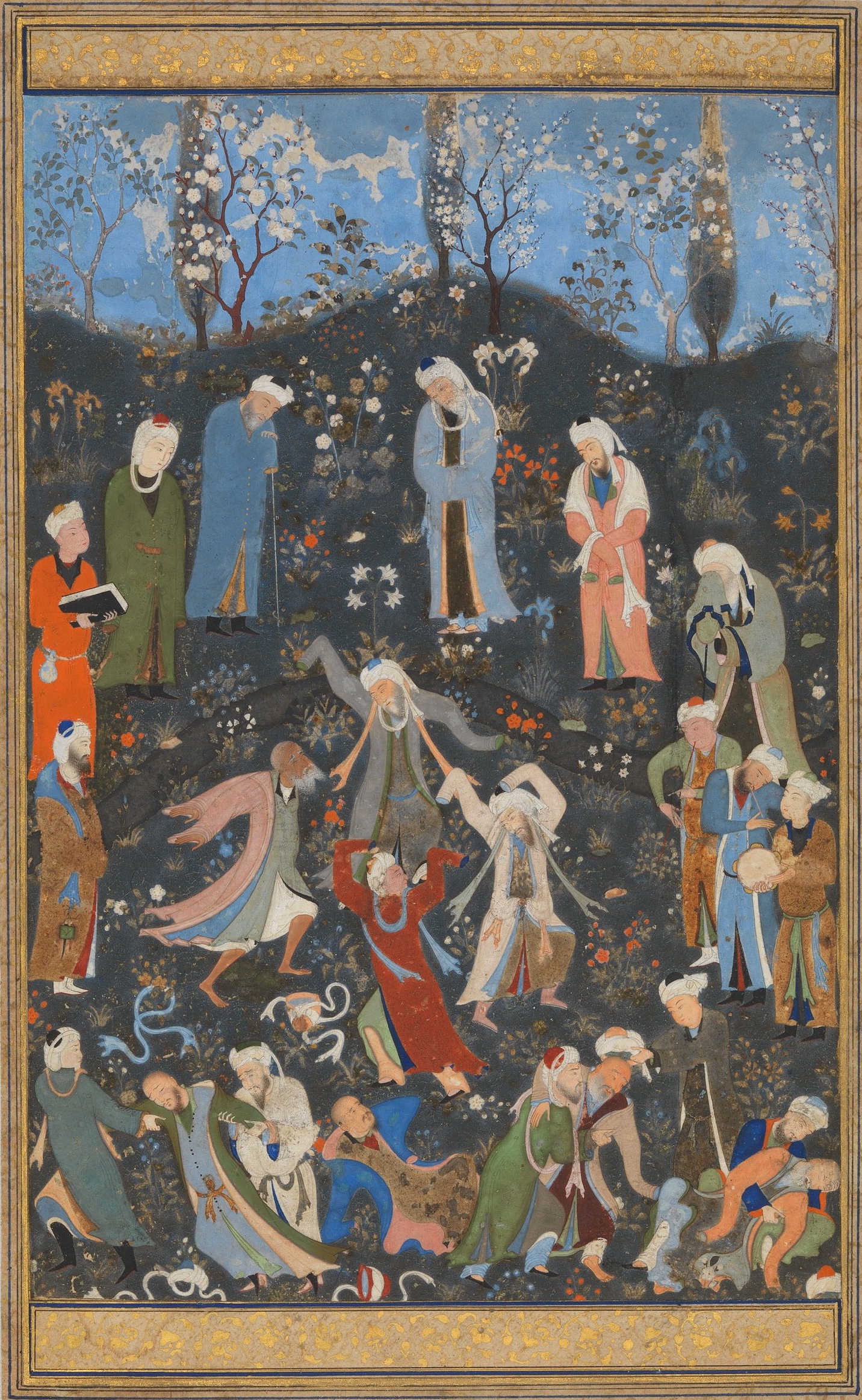|
─░brahim Hakk─▒ Erzurumi
Ibrahim Hakk─▒ Erzurumi (18 May 1703 ŌĆō 22 June 1780), a popular sufi saint of Turkey from Erzurum in eastern Anatolia - mystic, poet, author, astronomer, physicist, psychologist, sociologist and Hanafi Maturidi Islamic scholar. He was a Turkish Sufi philosopher and encyclopedist. Life and Works Having lost his mother and later his father at an early age, Ibrahim Hakk─▒ was raised by his uncle who educated him for a while. He met the Ottoman Sultan Mahmut I at istanbul in 1747. He returned to Erzurum, and was continuously interested in religious and scientific matters. Having written 15 books in the ŌĆ£manzumŌĆØ and regular styles and a great number in Turkish, Arabic, and Persian, amongst Ibrahim Hakk─▒'s most important works are the ''Divan'' and ''Marifetname''. In 1756 he published '' Marifetname'' (''Book of Gnosis''), a compilation and commentary on astronomy, mathematics, anatomy, psychology, philosophy, and Islamic mysticism. It is famous for containing the fir ... [...More Info...] [...Related Items...] OR: [Wikipedia] [Google] [Baidu] |
Sufi
Sufism ( ar, ''aß╣Ż-ß╣Ż┼½fiyya''), also known as Tasawwuf ( ''at-taß╣Żawwuf''), is a mystic body of religious practice, found mainly within Sunni Islam but also within Shia Islam, which is characterized by a focus on Islamic spirituality, ritualism, asceticism and esotericism. It has been variously defined as "Islamic mysticism",Martin Lings, ''What is Sufism?'' (Lahore: Suhail Academy, 2005; first imp. 1983, second imp. 1999), p.15 "the mystical expression of Islamic faith", "the inward dimension of Islam", "the phenomenon of mysticism within Islam", the "main manifestation and the most important and central crystallization" of mystical practice in Islam, and "the interiorization and intensification of Islamic faith and practice". Practitioners of Sufism are referred to as "Sufis" (from , ), and historically typically belonged to "orders" known as (pl. ) ŌĆō congregations formed around a grand who would be the last in a chain of successive teachers linking back to Muha ... [...More Info...] [...Related Items...] OR: [Wikipedia] [Google] [Baidu] |
Siirt Province
Siirt Province, ( tr, , ku, Par├¬zgeha S├¬rt├¬) is a province of Turkey, located in the southeast. The province borders Bitlis to the north, Batman to the west, Mardin to the southwest, ┼×─▒rnak to the south, and Van to the east. It has an area of 5,406 km┬▓ and a total population of 300,695 (as of 2010). The provincial capital is the city of Siirt. The province is considered part of Turkish Kurdistan and has a Kurdish majority. The current Governor of the Siirt province is Ali Fuat Atik. History In order to Turkify the Kurds of Siirt, Law 1164 was passed in June 1927, which allowed the creation of Inspectorates-General (''Umumi M├╝ffeti┼¤lik,'' UM) that governed with martial law under a state of emergency. The Siirt province was included in the so called First Inspectorate General (''Umumi M├╝fetti┼¤lik,'' UM) in which an Inspector General governed with wide-ranging authority of civilian, juridical and military matters. The UM covered the provinces of Hakk├óri, Sii ... [...More Info...] [...Related Items...] OR: [Wikipedia] [Google] [Baidu] |
Tillo
Tillo () formerly Ayd─▒nlar is a district of Siirt Province of Turkey. The name was Ayd─▒nlar until November 2013, when it recovered its original Arabic name. Etymology The name of the town is derived from the ar, ž¬┘ä, translit=tell, lit=hill. Population The town is mostly inhabited by Arabs. Villages Gallery File:Ibrahim hakk─▒ shrine in siirt tillo.jpg, ─░brahim Hakk─▒ Erzurumi shrine in Tillo, Siirt Siirt ( ar, ž│┘Éž╣┘Éž▒┘Æž», Si╩┐ird; hy, šŹš▓šźųĆšż, S'gherd; syr, ▄Ż▄ź▄¬▄¼, Siirt; ku, S├¬rt) is a city in southeastern Turkey and the seat of Siirt Province. The population of the city according to the 2009 census was 129,188. History P ... File:Tillo Clock Tower 8882.jpg, Tillo Clocktower File:Tillo Cobbled Street 8865.jpg, Tillo Cobbled Street File:Tillo Street scene 8874.jpg, Tillo Street scene File:Tillo Old house 8779.jpg, Tillo Old house File:Tillo Old house 8864.jpg, Tillo Old house File:Tillo Old house 8872.jpg, Tillo Old house detail File:Tillo Res ... [...More Info...] [...Related Items...] OR: [Wikipedia] [Google] [Baidu] |
Observational Astronomy
Observational astronomy is a division of astronomy that is concerned with recording data about the observable universe, in contrast with theoretical astronomy, which is mainly concerned with calculating the measurable implications of physical models. It is the practice and study of observation, observing celestial objects with the use of telescopes and other astronomical instruments. As a space science, science, the study of astronomy is somewhat hindered in that direct experiments with the properties of the distant universe are not possible. However, this is partly compensated by the fact that astronomers have a vast number of visible examples of stellar phenomena that can be examined. This allows for observational data to be plotted on graphs, and general trends recorded. Nearby examples of specific phenomena, such as variable stars, can then be used to infer the behavior of more distant representatives. Those distant yardsticks can then be employed to measure other phenomena ... [...More Info...] [...Related Items...] OR: [Wikipedia] [Google] [Baidu] |
Encyclopedic
An encyclopedia (American English) or encyclop├”dia (British English) is a reference work or compendium providing summaries of knowledge either general or special to a particular field or discipline. Encyclopedias are divided into articles or entries that are arranged alphabetically by article name or by thematic categories, or else are hyperlinked and searchable. Encyclopedia entries are longer and more detailed than those in most dictionaries. Generally speaking, encyclopedia articles focus on ''factual information'' concerning the subject named in the article's title; this is unlike dictionary entries, which focus on linguistic information about words, such as their etymology, meaning, pronunciation, use, and grammatical forms.B├®joint, Henri (2000)''Modern Lexicography'', pp. 30ŌĆō31. Oxford University Press. Encyclopedias have existed for around 2,000 years and have evolved considerably during that time as regards language (written in a major international or a vernacu ... [...More Info...] [...Related Items...] OR: [Wikipedia] [Google] [Baidu] |
Tasawwuf
Sufism ( ar, ''aß╣Ż-ß╣Ż┼½fiyya''), also known as Tasawwuf ( ''at-taß╣Żawwuf''), is a mystic body of religious practice, found mainly within Sunni Islam but also within Shia Islam, which is characterized by a focus on Islamic spirituality, ritualism, asceticism and esotericism. It has been variously defined as "Islamic mysticism",Martin Lings, ''What is Sufism?'' (Lahore: Suhail Academy, 2005; first imp. 1983, second imp. 1999), p.15 "the mystical expression of Islamic faith", "the inward dimension of Islam", "the phenomenon of mysticism within Islam", the "main manifestation and the most important and central crystallization" of mystical practice in Islam, and "the interiorization and intensification of Islamic faith and practice". Practitioners of Sufism are referred to as "Sufis" (from , ), and historically typically belonged to "orders" known as (pl. ) ŌĆō congregations formed around a grand who would be the last in a chain of successive teachers linking back to Muhamm ... [...More Info...] [...Related Items...] OR: [Wikipedia] [Google] [Baidu] |
Ulema
In Islam, the ''ulama'' (; ar, ž╣┘ä┘ģž¦žĪ ', singular ', "scholar", literally "the learned ones", also spelled ''ulema''; feminine: ''alimah'' ingularand ''aalimath'' lural are the guardians, transmitters, and interpreters of religious knowledge in Islam, including Islamic doctrine and law. By longstanding tradition, ulama are educated in religious institutions ''(madrasas)''. The Quran and sunnah (authentic hadith) are the scriptural sources of traditional Islamic law. Traditional way of education Students do not associate themselves with a specific educational institution, but rather seek to join renowned teachers. By tradition, a scholar who has completed his studies is approved by his teacher. At the teacher's individual discretion, the student is given the permission for teaching and for the issuing of legal opinions ''( fatwa)''. The official approval is known as the '' ijazat at-tadris wa 'l-ifta'' ("license to teach and issue legal opinions"). Through time ... [...More Info...] [...Related Items...] OR: [Wikipedia] [Google] [Baidu] |
Copernican Heliocentrism
Copernican heliocentrism is the astronomical model developed by Nicolaus Copernicus and published in 1543. This model positioned the Sun at the center of the Universe, motionless, with Earth and the other planets orbiting around it in circular paths, modified by epicycles, and at uniform speeds. The Copernican model displaced the geocentric model of Ptolemy that had prevailed for centuries, which had placed Earth at the center of the Universe. Although he had circulated an outline of his own heliocentric theory to colleagues sometime before 1514, he did not decide to publish it until he was urged to do so later by his pupil Rheticus. Copernicus's challenge was to present a practical alternative to the Ptolemaic model by more elegantly and accurately determining the length of a solar year while preserving the metaphysical implications of a mathematically ordered cosmos. Thus, his heliocentric model retained several of the Ptolemaic elements, causing inaccuracies, such as the pla ... [...More Info...] [...Related Items...] OR: [Wikipedia] [Google] [Baidu] |
Istanbul
Istanbul ( , ; tr, ─░stanbul ), formerly known as Constantinople ( grc-gre, ╬ÜŽē╬ĮŽāŽä╬▒╬ĮŽä╬╣╬Į╬┐ŽŹŽĆ╬┐╬╗╬╣Žé; la, Constantinopolis), is the List of largest cities and towns in Turkey, largest city in Turkey, serving as the country's economic, cultural and historic hub. The city straddles the Bosporus strait, lying in both Europe and Asia, and has a population of over 15 million residents, comprising 19% of the population of Turkey. Istanbul is the list of European cities by population within city limits, most populous European city, and the world's List of largest cities, 15th-largest city. The city was founded as Byzantium ( grc-gre, ╬ÆŽģ╬Č╬¼╬ĮŽä╬╣╬┐╬Į, ) in the 7th century BCE by Ancient Greece, Greek settlers from Megara. In 330 CE, the Roman emperor Constantine the Great made it his imperial capital, renaming it first as New Rome ( grc-gre, ╬Ø╬Ł╬▒ ß┐¼ŽÄ╬╝╬Ę, ; la, Nova Roma) and then as Constantinople () after himself. The city grew in size and influence, eventually becom ... [...More Info...] [...Related Items...] OR: [Wikipedia] [Google] [Baidu] |
Mahmut I
Mahmud I ( ota, ┘ģžŁ┘ģ┘łž» ž¦┘ł┘ä, tr, I. Mahmud, 2 August 1696 13 December 1754), known as Mahmud the Hunchback, was the Sultan of the Ottoman Empire from 1730 to 1754. He took over the throne after the Patrona Halil rebellion and he kept good relations with the Mughal and Safavid Empires. Early life He was born at Edirne Palace on 2 August 1696, the son of Mustafa II (1664ŌĆō1703); his mother was Saliha Valide Sultan. Mahmud I was the older half-brother of Osman III (1754ŌĆō57). He developed a humped back. His father Mustafa II mostly lived in Edirne. Mahmud passed his childhood in Edirne. On 18 May 1702 he started his education in Edirne. When his father deposed himself from the throne he was brought to Istanbul and locked up in Kafes where he spent 27 years of his life. It is not known what kind of culture he acquired during this time, since he continued to play chess, write poetry, and deal with music. In addition for childhood and youth, there were dangers, especial ... [...More Info...] [...Related Items...] OR: [Wikipedia] [Google] [Baidu] |






